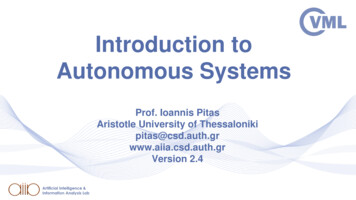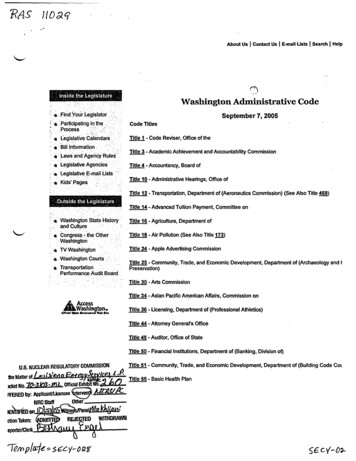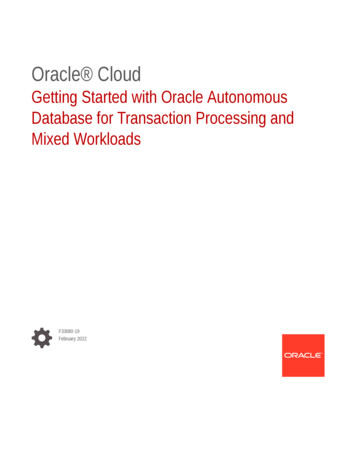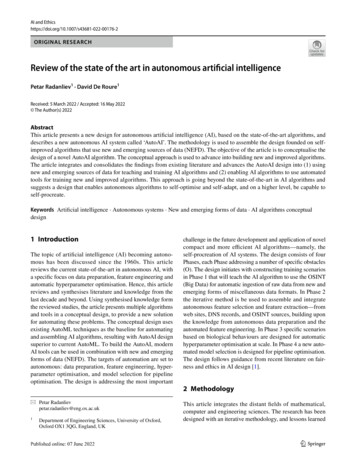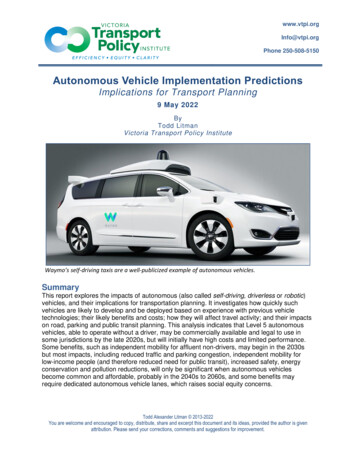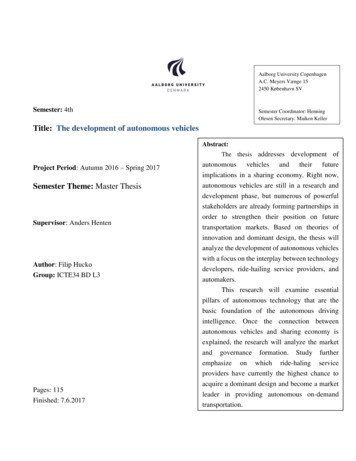
Transcription
Aalborg University CopenhagenA.C. Meyers Vænge 152450 København SVSemester: 4thSemester Coordinator: HenningOlesen Secretary: Maiken KellerTitle: The development of autonomous vehiclesAbstract:The thesis addresses development ofProject Period: Autumn 2016 – Spring 2017Semester Theme: Master ThesisSupervisor: Anders HentenAuthor: Filip HuckoGroup: ICTE34 BD L3Pages: 115Finished: 7.6.2017autonomous vehicles and their futureimplications in a sharing economy. Right now,autonomous vehicles are still in a research anddevelopment phase, but numerous of powerfulstakeholders are already forming partnerships inorder to strengthen their position on futuretransportation markets. Based on theories ofinnovation and dominant design, the thesis willanalyze the development of autonomous vehicleswith a focus on the interplay between technologydevelopers, ride-hailing service providers, andautomakers.This research will examine essentialpillars of autonomous technology that are thebasic foundation of the autonomous drivingintelligence. Once the connection betweenautonomous vehicles and sharing economy isexplained, the research will analyze the marketand governance formation. Study furtheremphasize on which ride-haling serviceproviders have currently the highest chance toacquire a dominant design and become a marketleader in providing autonomous on-demandtransportation.
AcknowledgementsFirst, I would like to thank my supervisor Anders Henten, who supported, guided and gave me a valuablelessons during the process of writing the thesis.Special credit belongs to my parents who mentally supported me to through my studies.Also I would like to salute to all of the people who are involved in a development of Autonomous vehiclesand related technology for those cars. They are working towards more sustainable and securetransportation for our future generations to come.Key WordsAutonomy, Autonomous, Self-driving, Transportation, Ride-hailing, Sharing Economy,DominantDesign, Business Models1
Table of Content1. Introduction . 61.1.1Potential Benefits of Autonomous vehicles . 71.1.2 Potential problems of Autonomous vehicles . 81.2 Motivation . 82. Methodology . 102.1 Research Design and Research Objectives . 102.2 Delimitation . 112.3 Literature review and the approach to theory development . 112.5 Topics & Tools . 143.Background . 163.1 Definitions. 163.2 Stages of autonomous driving . 173.2.1 Autonomous driving level classifications: . 173.3. Pillars of autonomous driving . 243.3.1 Perception - Sensing . 243.3.2 Mapping . 313.3.3 Driving Intelligence Policy . 323.4 The role of ICT in autonomy . 353.5 Connection between Autonomous cars and Sharing economy . 374. Theory . 424.1 Theory of Dominant Design . 424.2 Theory of Innovation . 474.2.1 Diffusion of Innovation. 484.2.2 Drivers of Innovation - Market adoption . 494.3 Business Model . 514.3.1 Definition . 512
4.3.3 Dominant Business model design and Customer Bonding . 534.4 Sharing economy . 564.4.1 Capital . 564.4.2 Timing . 564.4.5 Internet-based platforms . 575.Analysis. 585.1 Dominant design . 585.1.1 Dominat product design of a AVs . 585.1.2 Dominant Business model design . 605.2 Sharing Economy . 625.3 The role of OEM and Tech companies in stake . 645.3.1 Scenarios . 675.4 Case studies . 705.4.1 Simulation . 705.5 Current Leaders in the development of Autonomous vehicles . 775.5.1 Ford . 805.5.2 GM . 815.5.3 Google – Waymo . 825.6 Criteria Definition . 825.6.1 Strategy . 835.7 Key players – development . 845.7.1 Uber. 845.7.2 Lyft . 915.7.3 Tesla . 956. Discussion . 1017. Conclusion . 109Reference list . 1103
List of abbreviationsATAutonomous TaxiAVAutonomous vehicleB2BBusiness to BusinessBMBusiness ModelBMCBusiness Model CanvasC2CCustomer to CustomerCDVConventional Driven VehiclesEVElectric vehicleFIFOFirst in First outGPSGlobal Positioning SystemHWHardwareInstitute of Electrical andIEEEElectronics EngineersIoTInternet of ThingsIPRIntellectual Property RightsLiDAR Light Detection and RangingNational Highway TrafficNHTSA Safety AdministrationNLOSNon-line-of-sight propagationOriginal EquipmentOEMManufacturerR&DResearch and DevelopmentSWSoftwareTaSSTransportation as a ServiceV2IVehicle to infrastructureV2pVehicle to PedestrianV2VVehicle to VehicleV2XVehicle to X4
List of Figures:Figure 2.1: The connection between Lit. study and Emp. StudyFigure 2.2: Overview of the Empirical StudyFigure 2.3: Structure of the studyFigure 3.1: 5 levels of autonomy by SEAFigure 3.3: Radar PerformanceFigure 3.3: Radar PerformanceFigure 3.4:. Ultrasonic radar performanceFigure 3.5: LiDAR sensing of surroundingsFigure 3.6: LiDAR performanceFigure 3.7; Tesla Self Driving Car Demo Video AnalyzedFigure 3.8: How cars learnFigure 4.1: A-U model of product and process innovationFigure 4.2: Roger’s diffusion of innovation curveFigure 4.3: Four stages in the bonding continuumFigure 5.1: Industry BM shiftsFigure 5.2: The Four Stages of MobilityFigure 5.3. Old and new model of stakeholders in automotive industryFigure 5.4: AV mobility value chainFigure 5.5: End game scenarios based on ownershipFigure 5.6: Hourly demand for AT trips during the dayFigure 5.7: Locations of AT trip originsFigure 5.8: Vehicle operations and open request over the whole day for different AT fleet sizesFigure 5.9: Passenger wait times for each hourFigure 5.10: Average operation mode split for each hour theFigure 5.11: Vehicles categorized by the hourly share of idle timeFigure 5.12: Empty drive ratios for each hourFigure 5.13. The Navigant Research Leaderboard GridFigure 5.14: Criteria performance UberFigure 5.15: Criteria performance LyftFigure 5.16: Criteria performance TeslaFigure 6.1: Main Stakeholder relationshipsList of Tables:Table 3.1. Autonomous Vehicle Implementation StagesTable: 6.1 Criteria 7373747476879296101211025
1. Introduction1.1 OpeningThe invention of an automobile transportation shaped our society in a way how we commute, build ourcities and infrastructure, where we live and how we created a new industry. Automobile mobility provideus with a set of advantages, such as considerable freedom of transportation for those who can afford toown the car and it helps to maintain a sustainable economic growth. Yet, there are many side effects, thatmake the current vehicles unsustainable, if we take into account their safety, energy-relatedenvironmental impacts, traffic congestions, time spent by their operation and land use.[1][2]“Today’s Cars Are Parked 95% of the Time.” Paul Barter[3]Considering that cars are used only 5 percent of the time, and they spent the rest of the time parked,makes personal vehicle ownership unsustainable. Over the decades since the first motor vehicle wasintroduced by Karl Benz, car manufacturers took a steady incremental approach in technologydevelopment of cars. Following the recent trends in an automotive research and development, there is aclear sign that many organizations are racing towards fully autonomous vehicles with technology thatwill get rid of drivers as the one who controls the cars. Autonomous vehicles have the potential to disruptthe automotive market as we know it nowadays and reestablish the power of involved stakeholders. Asnew stakeholders come into a play in a market, new partnerships will be formed to gain the competitiveadvantage against the other organizations. With an upcoming advanced technology of autonomousvehicles, the current model of personal vehicle ownership will be challenged by ride-hailing serviceproviders.[4]This report - based on a literature study, case studies, and extensive market research, will evaluatethe relationship between several upcoming technologies and establishments related to a future ofautomotive industry. The paper is elaborating on how the autonomous cars can be used as a sharedresource to make them a more sustainable product. It exploits the connection between autonomousvehicles and sharing economy, by observing the current trends in the industry.Over the time, with a new radical innovation, the new dominant design will finally emerge. Beforethis will happen, the report will analyze the possible roles of the key stakeholders in a role as ride-hailingservice providers, who will operate a fleet of autonomous vehicles. With all of the stakeholders involvedin the research and development of the AVs, the report will observe the drivers in the innovation of thetechnology, and stakeholder’s individual interests in the new emerging market.Driving intelligence is such a huge complicated complex due to all of the processes that are happeningin the background. The sensing of the environment around the vehicle is one of the key pillars of6
autonomy. Having the ability to sense all of the necessary objects and identify them correctly is a must.But the system can’t rely only on sensing of the surroundings. Having the ability to define vehicle’slocalization with maximum accuracy and mapping the traffic structures along the way is important aswell. In the same time can’t put aside Driving Policy, that is responsible for decision-making that istransformed into controlling the actions of the vehicle.Studies say that 95% of all traffic fatalities are caused by a human error. Saying that 41% of thosetraffic fatalities are caused by recognition errors of drivers, what stays for a driver's inattention,distraction either external or internal and inadequate surveillance. Autonomous vehicles don’t encounterthis kind of problems, so fort they could prevent this kind of fatalities. Just in the United States, thiscould prevent 300 000 fatalities per decade. This number could be globally up to 10 million lives perdecade. Even though self-driving cars that are a factor of 100 safer than their predecessors without AI,fatal accidents will most likely occur, but in a smaller amount. There also arise a question, in a situationwhen a vehicle can’t prevent the crash and knows that it’s going to crash, how it will plan the crash itself?Plenty of moral questions can occur when the AI will have to deal with the crash.[5]Preventing crashes will have an impact on the economy as well. Taking into consideration a quickresearch on incidental cost, in 2015 US spent over 400billion USD only on peripheral costs related to caraccidents. Putting this into a context, 450billion USD is almost 19% of income tax revenue in 2015 thatfederal government earned. Government is fully aware of this and in 2016 President Barack Obamaproposed 4billion USD for development of autonomous cars.[6]Taking into consideration that AVs are safer we have to add that they are also more sustainable thatconventional vehicles. Right now, the transportation sector is considered as a second largest source ofCO2 in the US, where cars consume two billion barrels of oil annually. Taking into consideration thatautonomous cars always drive optimally to save the fuel and enhance the traffic flow[7]. In case thatAVs will be used a shared resource, it quite makes a sense to power them with electricity instead ofgasoline, what could further on decrease the carbon footprint of driving such vehicles.1.1.1 Potential Benefits of Autonomous vehiclesAutonomous vehicles bring plenty of potential benefits. While driving conventional vehicles causes arise of a cortisol level, known as a stress hormone, riders in AVs won’t experience the stress level relatedto driving and they could instead rest or work while traveling. Elimination of the taxi and truck driversneed will reduce the price for some of the services. Autonomous vehicles could be used by a non-drivers7
and will enable them to freely use cars without any dependence on other people. Increased safety willreduce many common accident risks and also related crash cost and insurance payments.Increased road capacity and reduced cost by supporting platooning of vehicles that are able to drivein close distance, what further means saving a fuel due to a decreased resistance of vehicles.Autonomous vehicle will offer more efficient parking when dropping off a passenger, the car canfind it’s parking spot by itself. What can reduce the waiting time for passenger and reduce the parkingprice, since the car can park itself in a cheaper area. AVs can reduce operational CO2 emissions ofvehicles and increase fuel efficiency, due to a fact that they will drive more optimally than a humandriver. If AVs will be used as a shared resource new car sharing services can provide several savings.1.1.2 Potential problems of Autonomous vehiclesAVs can increase costs related to additional car equipment, services, and further maintenance, and furtherinvestments in roadway infrastructure will be also necessary. AVs may introduce new risks, in a senseof system failures that can occur. What can mean that AVs could be less safe in certain situations andconditions. Being connected to a cloud and operated by a central unit system, there will be security andprivacy concerns related to cyber security threats, where vehicles can be controlled remotely. Furthervulnerable abuse of information, tracking and data sharing could violate the passenger privacy and thosecars could be used for some terrorist activities.1.2 MotivationIf we take into a consideration that we are using cars only 5% of the time and that human error in drivingis the causing too many fatalities, we will come into conclusion that cars itself are not the problem.Instead, we can redefine the problem by how we use cars, or by saying how we actually don't use them.If our cars will be capable to drive without us, why would we keep them idle in front of our homes andoffices? It then seems logical that using autonomous vehicles as a shared resource will create moresustainable and safer ways of transportation.The current development stage of AVs is in such a progress that we will soon put this concept into areality. Building a affordable electronic AVs in a high volume is now even closer to a truth, with theprice of a sensing technology and batteries going significantly down. Incoming 5G communicationtechnology will even further enhance the true power of vehicles connected to a cloud. The trends in8
sharing economy that we observe in a recent decade could shift the personal ownership model of carsupside down.There are many forces that drive the innovation and autonomous vehicles. Until nowadays, a carmanufacturers were the leaders in the automotive industry, by holding most of the competitive powerover the other stakeholders and suppliers. Now, with a new emerging technology; multiple newstakeholders are coming into a battle over the future automotive and transportation market.Companies such as Google, Uber, and Tesla are not the typical car manufacturers, yet they are thetop developers of the autonomous technology right now. The interplay between those tech developers,car manufactures and ride-hailing service providers will redistribute the power and roles in theautomotive market as we know it nowadays.9
2. MethodologyThe following chapter describes how the study was conducted and presents the individual researchmethods used to answer the stated research objectives.2.1 Research Design and Research ObjectivesThis sub-chapter will define the focus areas of the thesis research by formulating the research question.Considering the facts presented and discussed in the section above, the following research question hasbeen formulated.Research Question:How is formed the Dominant design of autonomous vehicles regarding to acurrent development stage of the autonomous vehicles and what is the role ofride-hailing service providers in a future of transportation?Due to a reason that the research question above is extensive and in order to make a bigger picture abovethe topic and the market, several sub-questions were formulated.Sub questions: What is the connection between AVs and ride-hailing service?How do we classify the development stages of AVs?What is the role of Sensing, Mapping and Driving Policy in Autonomy?Who are the main stakeholders in the future of ride-hailing services, and how those stakeholderscould possibly divide the responsibilities and the power?Who are the current leaders in the development of AVs, and what is the current State of the Artof AVs development?What are the possible business models for companies that will offer autonomous ride hailingservices?Which organizations have the highest chance to dominate the autonomous ride-hailing marketand capturing the dominant design?10
2.2 DelimitationRegarding the research question and its sub-questions, the study is exploring, how the dominant designof AVs is formed with the current research and development of AVs. More importantly, it’s focusingtowards the organizations that announced that they want to operate a fleet of AVs for a ride-hailingservice, where the car is becoming a shared resource. There are multiple types of design, such as thephysical design of the product, quality of the product/service or the design of the business model.Primarily, the research is exploring the dominant business models related to this topic and is furtherevaluating the potential success of dominating the market according to the selected criteria for evaluation.Thesis isn’t elaborating on specific topics related with autonomy such as moral dilemmas, reboundeffect, liability, regulation and security threats to simply narrow down the research as much as possible.Even though those topics are highly relevant to future of autonomous transportation, they would cause adistraction of focus around the core of the thesis. Scope of the study is focusing only towards NorthAmerican and European ride-hailing markets.2.3 Literature review and the approach to theory developmentThe research consists of two parts and is divided into a literature an empirical evidence sections. Whileliterature review gives us the context and the theoretical framework of the studies and publications thathave been published, empirical study give us the issues from the case studies[8]. Both of the methodswere conducted in a parallel, while the literature study was conducted before the empirical study in orderto find the theoretical awareness. Later during the study, this theoretical knowledge helped to form andbacked up the results in the analysis.Figure 2.1: The connection between Lit. study and Emp. Study11
This study is based on deductive theory development, that use the academic literature for the theorydevelopment. Based on the premises from the theory, the collected knowledge and premises are in theresearch: tested, applied and validated. Deductive reasoning is based on a logic, where in the process ofreasoning from one or multiple premises we should come to a logically predictable conclusion [8]. Inthis paper, the knowledge from the theory will be validated with the collected data from case studies andreports. The individual findings in the analysis will reflect the patterns observed in a literature review.As a methodological choice, the study is using qualitative research design that helps us to study thebehavior and patterns that shape the future of the on-demand transportation nowadays.Figure 2.2: Overview of the Empirical StudyFigure 2.2. represents the overview of the study and it’s continual flow. The study has alsoexploratory design because the paper is identifying the current situation in the market and is trying toconnect the variables and relationships between the main stakeholders for the future of the autonomy andon-demand transportation.“The emphasis in explanatory research is to study a situation or a problem in order to explain therelationship between variables.”[9]Analyzed data will be gathered from different literature sources, both primary and secondaryliterature sources. Academic papers, publications, reports, conference papers and case studies weresourced from a primary literature. Together with secondary literature sources such as articles, conferencekeynotes, journals, etc.12
TheoryCollected theory in the study serves as a theoretical knowledge background for the analysis of the report.Selected theories reflect the research focus and help to explain the current trends in the automotiveindustry. Theory of Dominant Design explains the premises why some companies are able to dominatethe market while other are getting behind. This theory foundation together with a Business models theorywill be useful further to see which business models of ride-hailing companies have the highest potentialto succeed once the technology for AVs is ready and approved by a regulator. Theory of Innovation isgiving us an insights of certain drivers of innovation. This knowledge will be reflected upon a currentstage of the AVs development and how are the key stakeholders involved in this phase. In a Sharingeconomy chapter, basic information about platforms, scaling and sharing resources will be introduced.2.4 Reading guidelinesPurpose of this part of the paper is to get familiar with an outline of the study, and understand the contextof individual chapters.Figure 2.3: Structure of the study13
Introduction chapter is mentioning a set of challenges in automotive transportation that autonomy couldsolve. Based on those challenges the research question and research objectives are formulated in aMethodology section. Methodology section further explains research methods and data collection. In aBackground chapter the paper describe a couple of terms related to a problematic, there are mentionedthe stages of autonomy and explained what the technological requirements for those stages. Theorychapter contains the theoretical framework of this paper, with collected knowledge from a literature.Based on the data collected from a research, in Analysis chapter, this knowledge and premises from theliterature are questioned, tested, and validated. In the end of the Analysis, the paper elaborates on themain research question, and provide an answer to this question based on the criteria evaluation of thethree competing ride-hailing companies. In a Discussion chapter, the paper comments on the foundingsfrom the study. Conclusion serves as an assessment of the study.2.5 Topics & ToolsThe study consists of the following topics:List of key developers of AVs that the thesis is going to elaborate on. The whole research will be thenfocused towards those stakeholders and comparing them with each other in a different sub-chapters.Drivers that move the innovation process of autonomous cars and ride-sharing markets. Those resultswill be based on the theory of dominant design and theory of innovation.Sharing economy that analyze the role of using car as a shared resource and how it can reshape thetransportation system as we know it nowadays.Techniques for a customer bonding. A market for autonomous transportation is enormous. After itspenetration thesis will elaborate on how to get and keep a customer while crushing the competition.Observed use cases bring value for a better understanding of how those companies work, what processesand strategies they are implementing and what are they trying to accomplish.The study consists of the following Tools:Business models as a tool to express how the company create value and capture the profit from its actions.14
SWOT analysis points out the Strengths, Weaknesses, Opportunities and Threats of the organizations. Inthe study, the SWOT analysis will be applied to exploit the individual qualities and vulnerabilities of theorganizations that have the interest to operate a fleet of ATs services.15
3.BackgroundIntroThe background chapter will introduce to us some of the insights from the autonomous industry. First,it's explaining and defining few of the terms related to autonomy, autonomous vehicles and selectedservices related to using a car as a shared resource. Following a description of AVs development stages,where it is explaining how the advanced technology is taking over the vehicles control in different stages.
development of cars. Following the recent trends in an automotive research and development, there is a clear sign that many organizations are racing towards fully autonomous vehicles with technology that will get rid of drivers as the one who controls th




